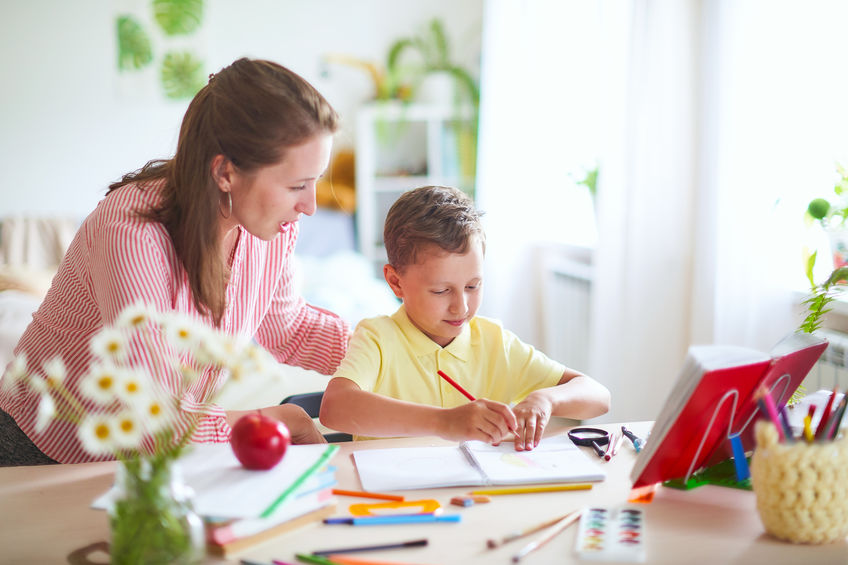Top Tips for Home Learning
Many parents across the U.K. are now well into their second long stint of ‘homeschooling’ due to the COVID-19 pandemic. Whilst everyone’s circumstances differ and some children are really benefitting from learning remotely, it’s fair to say that many parents and children are facing challenges with remote learning. Parents are often juggling home learning with their own work and caring for any younger siblings. Children and teenagers are facing new difficulties with learning, from difficult wi-fi connections and feeling overwhelmed on video calls, to struggling to stay motivated at home. Parents – please know that you aren’t alone in your struggles, it’s ironic that as I’m writing this I’m helping my eldest with phonics and have my pre-schooler sat on my lap!
 Schools have really stepped up to the mark with their organisation and delivery of remote learning for children at home. And although we are incredibly lucky to (mostly) have the technology to support learning at home, video calls can rarely compete with face-to-face teaching. As a former teacher/SENDCO and now a tutor for children with Special Educational Needs and founder of The SEN Resources Blog (www.senresourcesblog.com), I’m regularly asked how we, as parents, can help make home learning easier for children. I think it’s important to first think about what children are finding difficult about home learning and then look at how to make it better whilst recognising that these are unprecedented times and we don’t have all the answers!
Schools have really stepped up to the mark with their organisation and delivery of remote learning for children at home. And although we are incredibly lucky to (mostly) have the technology to support learning at home, video calls can rarely compete with face-to-face teaching. As a former teacher/SENDCO and now a tutor for children with Special Educational Needs and founder of The SEN Resources Blog (www.senresourcesblog.com), I’m regularly asked how we, as parents, can help make home learning easier for children. I think it’s important to first think about what children are finding difficult about home learning and then look at how to make it better whilst recognising that these are unprecedented times and we don’t have all the answers!
Firstly, one common difficulty children are facing with remote learning is lack of motivation. Sat at home in front of a computer is by no means as motivating as the buzz of a classroom! Many children thrive on praise to motivate them and not being in the classroom with their teacher and teaching assistants giving them immediate positive reinforcement, can be tough. Parents can help motivate their children at home with lots of praise and feedback on their work. Making sure also to read and communicate with their children about the feedback their teachers have given them remotely.
Rewards can also work wonders for children, I’m by no means suggesting elaborate gifts each time they complete their work…but instead, simple rewards that are appropriate. This could be screen time (playstation, xbox, tablet) if they complete all their work to a high standard that day. Or choice of a special dinner that evening or movie night on a Friday at home. Primary schools often use Golden Time at the end of the week as a lovely way of rewarding younger children for their hard work during the week. As part of Golden Time, children get ‘free’ or unstructured time to choose which toys they would like to play with. This is something that can easily be replicated at home and has the added bonus of freeing parents up a little bit more once a week.
 A good routine can also help keep children motivated and on track. Adding structure to a child’s day helps them to visualise how their day and week will pan out. This can be particularly important for some children with Special Educational Needs who can find changes and lack of routine difficult. Making a timetable of the day together also gives children more ownership over their day, which is a powerful thing and motivating in its own right. John Galloway wrote a brilliant article providing advice about exactly this and it can be found here (www.wordshark.co.uk/the-need-for-structure-wherever-and-whenever-we-learn/).
A good routine can also help keep children motivated and on track. Adding structure to a child’s day helps them to visualise how their day and week will pan out. This can be particularly important for some children with Special Educational Needs who can find changes and lack of routine difficult. Making a timetable of the day together also gives children more ownership over their day, which is a powerful thing and motivating in its own right. John Galloway wrote a brilliant article providing advice about exactly this and it can be found here (www.wordshark.co.uk/the-need-for-structure-wherever-and-whenever-we-learn/).
Another difficulty children face at home is trying to concentrate with the distractions around them. It’s idealistic to imagine that children are all sat at home at a desk in a quiet space with a parent working 1:1 to help support their home learning. In reality, children are sat at kitchen tables, in their bedrooms and on makeshift desks. They have busy parents, who through no fault of anybody’s, can’t dedicate all their time to their child’s learning – as they have their own work to do, housework to attempt to keep up with and younger siblings to feed, change and occupy! The child may have noisy younger siblings in the background wanting to play with them, a pet dog that needs walking and limited wi-fi as it’s being shared between multiple devices (if they have them at all.)
 So how can we help with this? I wrote recently, on The SEN Resources Blog, about helping children to concentrate at home and the main take home point was that even making the smallest adaptations at home can make a huge difference. I am by no means suggesting parents need to dedicate a room to their children, all set up with desk, computer etc. Instead, I’m saying try to make the best changes you can for your circumstances. This could be sectioning off part of the kitchen table with a piece of cardboard, to provide a physical barrier to noise and visual distractions when they are working. It could be letting them use ear defenders or noise cancelling headphones whilst working. Or giving your younger siblings quiet activities to complete (as difficult as this might sound!) whilst your school age child is working. Some parents are also getting up earlier to start work, so they can finish earlier and concentrate on school work with their children then. Like I say, whatever you can do in your circumstances can make a difference.
So how can we help with this? I wrote recently, on The SEN Resources Blog, about helping children to concentrate at home and the main take home point was that even making the smallest adaptations at home can make a huge difference. I am by no means suggesting parents need to dedicate a room to their children, all set up with desk, computer etc. Instead, I’m saying try to make the best changes you can for your circumstances. This could be sectioning off part of the kitchen table with a piece of cardboard, to provide a physical barrier to noise and visual distractions when they are working. It could be letting them use ear defenders or noise cancelling headphones whilst working. Or giving your younger siblings quiet activities to complete (as difficult as this might sound!) whilst your school age child is working. Some parents are also getting up earlier to start work, so they can finish earlier and concentrate on school work with their children then. Like I say, whatever you can do in your circumstances can make a difference.
We also must not underestimate the importance of regular breaks from learning. A day punctuated with short, snappy periods of home learning with regular breaks, is likely to be much more productive than a longer slog sat at a desk. This is especially true for younger children. Breaks from learning are also hugely beneficial if they involve physical movement, this could be a walk or online kids workout… or just time running around and playing. If a child has additional sensory needs, having movement breaks can be imperative to learning.
For parents of children with Special Educational Needs it’s also important to make sure you’ve got any resources they use in school to support your child, at home with you now. For example, if your child can access written work tasks at school due to them using a writing slant, you need to speak to the school and ask to borrow one whilst your child is learning at home. Likewise, if your child uses coloured overlays, work on coloured paper or certain size text to read – these all need to be replicated at home, to ensure your child is receiving the adjustments they need to access the work. Speak to your child’s teacher and/SENDCO to ensure this is happening.
 One problem that is difficult to solve is children missing their friends. It’s also quite heart-breaking to hear. And whilst it would be so much better if they were running around in a playground with their friends, we have to make do and make the best of what we have got. A lot of children are fortunate that they can use technology to still keep in contact with their friends and I don’t think the importance of this should be underestimated. This could be teens chatting together whilst playing computer/console games, talking on the phone or social media (with supervision) or both children and teens seeing each other on video calls. Making time for these virtual social interactions will help. I also think it’s important to take their concerns about friendships seriously and properly listen to them about their worries. It can be so easy to brush children’s concerns off, with comparisons of how much worse others have got it, or how it’s ‘not the end of the world’. But this isn’t particularly helpful. Instead, ensure your children feel heard and try to make sure they are finding a way to keep in touch with their peers.
One problem that is difficult to solve is children missing their friends. It’s also quite heart-breaking to hear. And whilst it would be so much better if they were running around in a playground with their friends, we have to make do and make the best of what we have got. A lot of children are fortunate that they can use technology to still keep in contact with their friends and I don’t think the importance of this should be underestimated. This could be teens chatting together whilst playing computer/console games, talking on the phone or social media (with supervision) or both children and teens seeing each other on video calls. Making time for these virtual social interactions will help. I also think it’s important to take their concerns about friendships seriously and properly listen to them about their worries. It can be so easy to brush children’s concerns off, with comparisons of how much worse others have got it, or how it’s ‘not the end of the world’. But this isn’t particularly helpful. Instead, ensure your children feel heard and try to make sure they are finding a way to keep in touch with their peers.
Lastly, there’s no hiding from the fact that as much as we’d like to shelter our children from the COVID-19 pandemic, even young children are aware of the threat of COVID-19 to people’s health.
 And anxiety over the virus and our lack of control will undoubtedly be affecting their wellbeing and consequently their home learning. Again, finding time to talk to and listen to your children’s worries about this is really important. As is reaching out to professionals if you’re feeling worried about your child’s anxiety.
And anxiety over the virus and our lack of control will undoubtedly be affecting their wellbeing and consequently their home learning. Again, finding time to talk to and listen to your children’s worries about this is really important. As is reaching out to professionals if you’re feeling worried about your child’s anxiety.
Whilst there are certainly many challenges to remote learning, I like to think that having experienced it, we will come out of it stronger and with some positives. These may be positives, such as stronger home-school relationships from weeks of communication between parents and teachers about home learning activities. I also think we will have developed a greater understanding of what our children are learning in school and how our own children learn best.
By Georgina Durrant
Georgina is a former teacher/SENDCO and founded The SEN Resources Blog(www.senresourcesblog.com), which is an award winning site for parents and teachers of children with Special Educational Needs. She also tutors children with Special Educational Needs and is an author for Jessica Kingsley Publishers.







